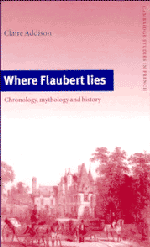Book contents
- Frontmatter
- Contents
- Publisher's note
- Acknowledgement
- Abbreviations and conventions
- Introduction
- 1 The Flaubert dates
- 2 The colours of time in the first Education sentimentale
- 3 Conception, birth, death in Madame Bovary
- 4 Heads and tails in Salammbô
- 5 Two-timing in L'Education sentimentale
- 6 The Hundred Days of Bouvard et Pécuchet
- 7 Petit dictionnaire de Flaubert
- Conclusion
- Diachronic and synchronic charts
- Bibliography
- Index
- Cambridge Studies in French
5 - Two-timing in L'Education sentimentale
Published online by Cambridge University Press: 09 October 2009
- Frontmatter
- Contents
- Publisher's note
- Acknowledgement
- Abbreviations and conventions
- Introduction
- 1 The Flaubert dates
- 2 The colours of time in the first Education sentimentale
- 3 Conception, birth, death in Madame Bovary
- 4 Heads and tails in Salammbô
- 5 Two-timing in L'Education sentimentale
- 6 The Hundred Days of Bouvard et Pécuchet
- 7 Petit dictionnaire de Flaubert
- Conclusion
- Diachronic and synchronic charts
- Bibliography
- Index
- Cambridge Studies in French
Summary
‘Le 15 septembre 1840’: Louise Révoil Colet's thirtieth birthday is writ large at the beginning of a book whose two-volume first edition appeared in November 1869 bearing the date 1870 (11, 8). If Rosanette ‘devenait vieille’ at the age of twenty-nine (11, 127), then thirty is old enough: in 1870, Louise Colet would be sixty. Hortense Baslin's first act of prostitution at the age of fifteen occurred at the Croix-Rousse (11, 128); Louise Révoil was living in the Croix-Rousse at the age of fifteen (D45, 142). Yet the ‘Muse's’ vituperative brand of revenge is not Flaubert's, as the novel's chronological structure shows: a continuous narrative from 15 September 1840 to 5 December 1851 is followed by a double coda which repeats the encounters of the novel's first two chapters, this time on 22 March 1867 and 22 November 1868 respectively. The events of the impossibly situated 5 December 1851 cause a flight in time and space which cannot efface the impact of the day that is hors temps. On 5 December 1835, Louise Révoil married Hippolyte Colet; on 5 December 1851, Louise Roque married Charles Deslauriers (11, 159). Where there is vengeance, there is also homage. Over and against efforts at subverting time, there are the incontrovertible facts of time. The tension in ES11 is created by the massive forces of temporal manipulation and symbolisation set against the resistant immutability of dates which cannot be denied. Using the terminology of the novel's end, we shall examine the tension between ‘logical’/ligne droite time and the ‘sentimental’ time of ‘mille choses secondaires’ (11, 162).
- Type
- Chapter
- Information
- Where Flaubert LiesChronology, Mythology and History, pp. 130 - 186Publisher: Cambridge University PressPrint publication year: 1996



